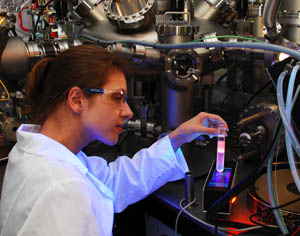Jul 23 2010
We live in the age of dynamic development of various nanotechnologies.
 PhD student, Ewelina Kalwarczyk from the Institute of Physical Chemistry of the Polish Academy of Sciences with a sample in which fluorescent semiconductor nanoparcticles were separated.
PhD student, Ewelina Kalwarczyk from the Institute of Physical Chemistry of the Polish Academy of Sciences with a sample in which fluorescent semiconductor nanoparcticles were separated.
A side effect of their popularisation is the fact that more and more nanometric structures get into the environment. Many of these structures are very dangerous for man. Carbon nanotubes may be of length similar to the size of a cell – more than ten micrometers – with a diameter of just several nanometres; such an object acts like a needle and it is hard to remove it from the body. Nanostructures that have a round shape, made of hazardous materials, e.g. cadmium selenide particles, are also dangerous. Meanwhile, methods of mechanical and chemical treatment of sewage do not eliminate nano-pollutants, whereas laboratory methods are successful only in the case of little volumes of liquids. The Institute of Physical Chemistry of the Polish Academy of Sciencies (IPC PAS) developed an innovative sewage treatment process allowing nanometric size pollutants to be separated. The process can be used on an industrial scale. "The solution turned out to be so simple, cheap and effective that it is already protected by four patents," emphasises Prof. Robert Ho³yst, director for scientific affairs of the IPC PAS.
The method for the separation of nanometric particles, developed within the last five years, consists in adding to the polluted solution two substances: surfactant (i.e. surface active agent, such as soap) and polymer (e.g. inexpensive and environment-friendly PEG). "If we match concentrations properly, all tiny pollutants will gather in the upper, floating layer with consistency of thin soap, under which there is clean water with polymer which can be easily recovered," says D.Sc. Marcin Fialkowski from the IPC PAS. The upper layer of the surfactant can be collected by mechanical methods in a simple way, and then it can be utilised or processed in order to recover the substances it contains.
The physical mechanism responsible for the separation of the substance in the solution is connected with the difference between geometrical sizes of surfactant and polymer particles. Surfactants – substances that are dominant components of all cleaning agents – create in solutions aggregates called micelles. They can have various shapes but they often look like ordinary balls. Polymer, on the other hand, has a form of a ball of wool, which also resembles a ball. If two "balls" of a surfactant get close enough to each other, the smaller "ball" of polymer will not be able to squeeze between them and will remain at a certain distance, called radius of gyration. Therefore, when micelles of a surfactant approach each other and the distance between them is smaller than twice the radius of gyration, an empty space is created between them. This results in a difference in concentrations of polymer and osmotic pressure related to this difference. Water flows out from among micelles, they get closer and within several dozens of minutes phases in the solution become separated. The process occurs even when charged polymer of the same sign is added into the solution containing ionic surfactant.
The research showed that if there were any particles in the original solution, they gathered in the layer rich in surfactant. "During one of the experiments we studied a solution of gold nanoparticles which had the size of five nanometres. After several percent of soap and approx. 10% of polymer had been added, a viscous and elastic layer with a surfactant was created on the surface. It contained particles of gold which, being heavier than water, under different conditions should fall down to the bottom,” describes Ewelina Kalwarczyk, a PhD student from the Department of Soft Condensed Matter and Fluids of the IPC PAS. The method is effective also in the case of detergents that become denser and are raised to the surface.
It is particularly important for the application of this method on an industrial scale that upon the completion of the process, polymer remains in water from which it can be nearly completely recovered. The only substance that is used up fully is the surfactant, i.e. soap, in which nano-pollutants are closed. Tests which lasted 11 months did not show any changes in the physical and chemical stability of the surfactant collected, which means that the particles contained in it are effectively isolated from the environment.
Surface layer being created in solutions has an orderly hexagonal structure. Since the type of the order depends only on concentration, structures of this type are called lyotropic liquid crystals. Thanks to the method being described, carefully selected nanoparticles can be easily introduced into matrices that form the structures. The matrices can be fixed and the organic part can be removed. Therefore, the method developed in the Institute of Physical Chemistry of the PAS can be used not only to treat sewage but also to produce composite materials containing admixtures of gold, platinum, silver, semiconductors, carbon nanotubes, etc. This type of materials can be used for the construction of solar cells and various types of catalysts, e.g. car catalysts.
Source: http://ichf.edu.pl/